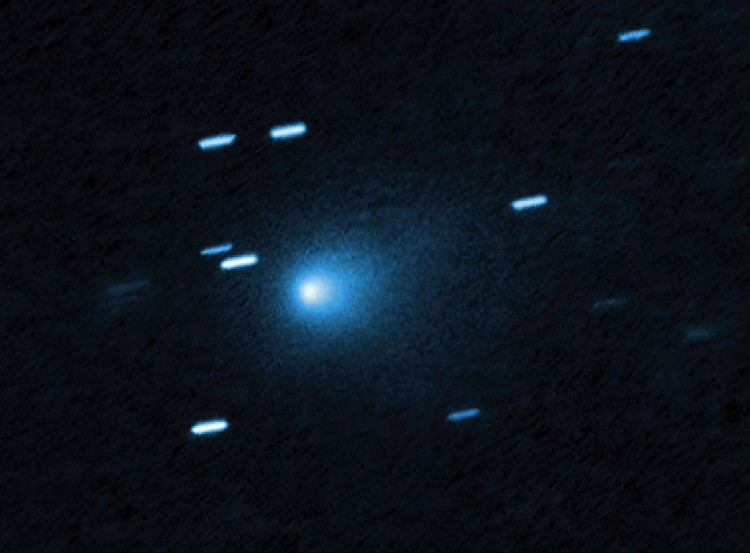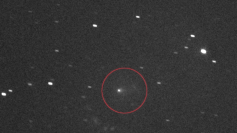An interstellar object passing through the Solar System is prompting renewed scientific scrutiny as new radio observations support its classification as a comet, even as fresh imaging raises the possibility that it fragmented following its close pass near the Sun. The object, known as 3I/ATLAS, is only the third interstellar visitor ever detected, and its behavior continues to generate intense academic debate and widespread public speculation.
Researchers at the South African Radio Astronomy Observatory confirmed the detection of hydroxyl (OH) absorption lines at 1665 MHz and 1667 MHz using the MeerKAT radio telescope system, a network of 64 antennas each 13.5 meters in diameter. The detection corresponds to typical cometary outgassing behavior. "OH absorption was detected on the 1665 MHz and 1667 MHz lines," the research team reported, noting that the geometry of the object during its close approach to the Sun favored absorption rather than emission.
The detection indicates that 3I/ATLAS is releasing gas as ice sublimates under solar radiation-an expected process for comets during perihelion. The hydroxyl radical is a common tracer in comet studies, often used to track water dissociation in the near-Sun environment. The MeerKAT observation on October 24 came after two earlier attempts in September yielded no detectable signal.
Astrophysicist Avi Loeb acknowledged the new findings in a Medium post, writing that "no radio detection of 3I/ATLAS has been reported so far, other than the OH absorption signal," while adding that long-term monitoring of gas production and surface behavior will be necessary for definitive conclusions. Loeb previously encouraged observatories to track the comet, noting that its arrival direction was within nine degrees of the origin point of the 1977 "Wow!" signal.
Yet while the spectral data reinforces the classification of 3I/ATLAS as a natural icy body, images captured after perihelion have raised questions about whether the object has undergone a significant structural change. New photographs taken by British astronomers Michael Buechner and Frank Niebling show an elongated dust structure forming what Loeb described as a "massive 'anti-tail'" and a secondary "smoking" jet.
3I/ATLAS grows two tails!
Fresh images from Spain by Frank Niebling and Michael Buechner show the interstellar comet 3I/ATLAS with not one, but two impressive tails!
A “smoky” (possibly gaseous) tail stretches up to the upper right, while a bright antitail made of dust… pic.twitter.com/1QCF1r3cc7 — Star Walk (@StarWalk) November 10, 2025
Loeb argues that the intensity of the gas release-estimated at roughly 4.4 million pounds of mass loss per second at perihelion-may indicate breakup. "Was the dramatic mass loss and brightening of 3I/ATLAS at perihelion evidence that it disintegrated?" he wrote. He suggested the object could have fragmented into "at least 16 equal pieces, and likely many more," which would produce a rapid increase in surface area and luminosity.
The observed jets stretch approximately 620,000 miles toward the Sun and 1,860,000 miles away from it, according to Loeb's calculations. He noted that to sustain such mass loss rates, the absorbing surface area of 3I/ATLAS at perihelion would need to be larger than 617 square miles-equivalent to a spherical object over 14 miles across. That estimate is significantly larger than earlier size assessments based on Hubble and Webb observations from mid-2025.
Loeb has also acknowledged an alternative possibility: that if the object did not break apart despite losing mass, a non-natural propulsion mechanism could explain its jets. "Technological thrusters require a much smaller mass loss in order to produce the observed jets around 3I/ATLAS," he wrote, adding that "alien-tech thrusters might employ yet higher exhaust speeds, reducing the required mass loss by several orders of magnitude."
Radio scientists and comet specialists overwhelmingly reject the artificial-origin scenario, noting that the OH detection strongly reinforces a natural explanation. But the object's apparent structural changes will be monitored closely as it approaches Earth on December 19 and later passes within 53 million kilometers of Jupiter on March 16, when NASA's Juno spacecraft will attempt additional radio-frequency observations.





